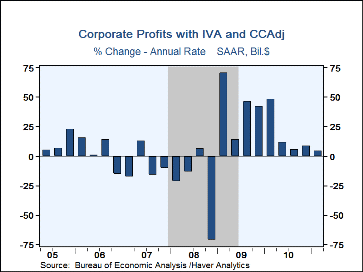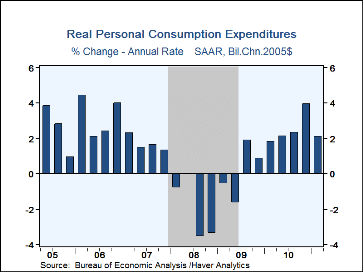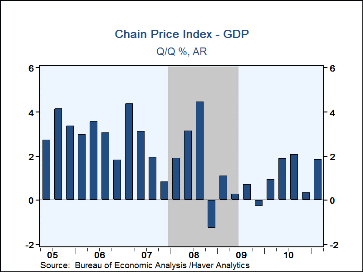 Global| May 26 2011
Global| May 26 2011Slow U.S. GDP Growth Unrevised
by:Tom Moeller
|in:Economy in Brief
Summary
In its second look at the economy last quarter, the Commerce Department didn't find much that was materially different versus last month's picture.Real GDP grew 1.8% (SAAR), still the weakest growth since Q2'10. The Q1 figure fell [...]
In its second look at the economy last quarter, the Commerce Department didn't find much that was materially different versus last month's picture.Real GDP grew 1.8% (SAAR), still the weakest growth since Q2'10. The Q1 figure fell short of Consensus expectations for 2.2% growth.
Reported for the first time were corporate profits which rose 1.3% (8.5% y/y). Profits from abroad led the gain with a 12.5% increase (8.1% y/y). Nonfinancial sector earnings rose 5.2% (10.0% y/y) but earnings in the financial sector fell 16.6% (+5.4% y/y).
Weakness in last quarter's GDP components was widespread. Moreover, the weakened growth in personal consumption of 2.2% versus Q4 was a downward revision. Offsetting this was an improved, though still modest, gain in business fixed investment of 3.4%. Lessened was the decline in residential investment, now put at -3.3%. Finally, the decline in government spending was unrevised and down at a 5.1% rate, the most for any quarter since 1983. Lower defense purchases caused federal spending to fall at a deepened 11.7% rate while budget shortfalls pulled state & local spending down at a 3.2% rate, the most in a year.
Deterioration in the foreign trade deficit subtracted an unrevised 0.1 percentage points from last quarter's GDP gain, though export growth of 9.2% (8.4% y/y) was revised up and exceeded the increased 7.6% rise (10.0% y/y) in imports. Quicker inventory accumulation added an increased 1.2 percentage points to GDP growth.
Price inflation as measured by the chained GDP price index quickened to an unrevised 1.9% rate, nearly double last year's gain. The price index for domestic final demand jumped 3.7% (1.6% y/y) and the price index for final sales rose 1.9% (1.5% y/y). The GDP figures are available in Haver's USECON and USNA databases and the expectations number is in AS1REPNA.
| Chained 2005 $, % AR | Q1'11 Prelim. |
Q1'11 Adv. |
Q4 10 |
Q3 10 |
Q1'11 Y/Y |
2010 | 2009 | 2008 |
|---|---|---|---|---|---|---|---|---|
| GDP | 1.8 | 1.8 | 3.1 | 2.6 | 2.3 | 2.9 | -2.6 | -0.0 |
| Inventory Effect | 1.2 | 0.9 | -3.4 | 1.6 | 0.0 | 1.5 | -0.5 | -0.5 |
| Final Sales | 0.6 | 0.8 | 6.7 | 0.9 | 2.3 | 1.4 | -2.1 | 0.5 |
| Foreign Trade Effect | -0.1 | -0.1 | 3.3 | -1.7 | -0.4 | -0.5 | 1.0 | -1.1 |
| Domestic Final Demand | 0.7 | 0.9 | 3.2 | 2.6 | 2.7 | 1.8 | -3.1 | -0.6 |
| Demand Components | ||||||||
| Personal Consumption | 2.2 | 2.7 | 4.0 | 2.4 | 2.7 | 1.8 | -1.2 | -0.3 |
| Business Fixed Investment | 3.4 | 1.8 | 7.7 | 10.0 | 9.5 | 5.7 | -17.1 | 0.3 |
| Residential Investment | -3.3 | -4.1 | 3.3 | -27.3 | -2.3 | -3.0 | -22.9 | -24.0 |
| Government Spending | -5.1 | -5.2 | -1.7 | 3.9 | 0.2 | 1.0 | 1.6 | 2.8 |
| Prices | ||||||||
| Chained GDP Price Index | 1.9 | 1.9 | 0.4 | 2.1 | 1.6 | 1.0 | 0.9 | 2.2 |
Tom Moeller
AuthorMore in Author Profile »Prior to joining Haver Analytics in 2000, Mr. Moeller worked as the Economist at Chancellor Capital Management from 1985 to 1999. There, he developed comprehensive economic forecasts and interpreted economic data for equity and fixed income portfolio managers. Also at Chancellor, Mr. Moeller worked as an equity analyst and was responsible for researching and rating companies in the economically sensitive automobile and housing industries for investment in Chancellor’s equity portfolio. Prior to joining Chancellor, Mr. Moeller was an Economist at Citibank from 1979 to 1984. He also analyzed pricing behavior in the metals industry for the Council on Wage and Price Stability in Washington, D.C. In 1999, Mr. Moeller received the award for most accurate forecast from the Forecasters' Club of New York. From 1990 to 1992 he was President of the New York Association for Business Economists. Mr. Moeller earned an M.B.A. in Finance from Fordham University, where he graduated in 1987. He holds a Bachelor of Arts in Economics from George Washington University.










